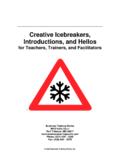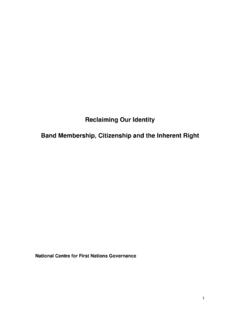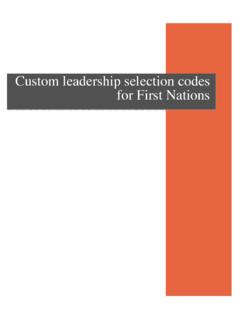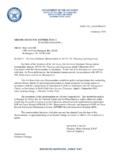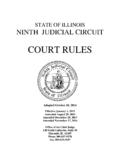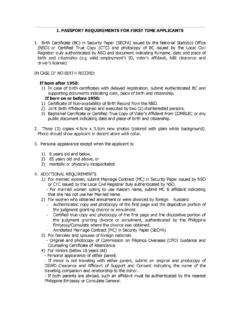Transcription of MEMORANDUM ON INDIAN STATUS AND BAND …
1 50544854 1 MEMORANDUM ON INDIAN STATUSAND band MEMBERSHIPSome membership Codes currently provide that persons will only be entitled toautomatic membership in a band or First Nation if both parents are also members of that band orFirst Nation. As a result of this membership rule, there are many community members across thecountry that cannot attain band membership unless a community referendum is held whichwould permit this to this context, the National Centre for First Nations Governance has requestedthat we provide an overview of the law governing INDIAN STATUS and band membership rulescurrently in place under the INDIAN Act, as well as an analysis of the implications of theseprovisions, for First Nations wishing to develop or revise their membership purposes of this analysis and for ease of reference, we have appended a copyof the relevant provisions of the INDIAN Act to this MEMORANDUM .
2 AnalysisIn 1985, Parliament introduced certain amendments to the INDIAN Act, which had adirect impact on the way in which INDIAN STATUS and band membership is determined (the 1985 Amendments ). Prior to the 1985 Amendments, persons who had INDIAN STATUS and who hadband membership were treated the same at law. As of April 17, 1985, however, the 1985 Amendments granted bands the ability to control their own membership by establishing bandmembership codes. As a result of this change, it is now possible for there to exist STATUS Indianswithout band membership , as well as legally recognized non- STATUS band members. By contrast,where a band chooses not to establish a band membership code, the INDIAN Act provides thatband membership will be determined by the Department of INDIAN Affairs and NorthernDevelopment ( DIAND ).
3 In this case, the regulations governing band membership where theband list is maintained by DIAND mirror those for determining a person s entitlement to Act ProvisionsThe INDIAN Act, 1985, c. I-5, uses a pure blood and ancestry test todetermine who is an INDIAN for purposes of the Act. In Section 2(1) of the INDIAN Act, INDIAN is defined as ..a person who pursuant to this Act is registered as an INDIAN or is entitled to beregistered as an INDIAN . The term STATUS INDIAN is used to refer to persons who are registeredor entitled to be registered as indians under the INDIAN Act. I have set out the relevant provisionsin greater detail below. Under the current Act, INDIAN STATUS is distinct and determined separatelyfrom band 1 Page 21. INDIAN StatusThe official list of STATUS indians in Canada is maintained by DIAND in the IndianRegister.
4 An individual entitled to be registered under the Act will not have his or her namerecorded in the INDIAN Register unless an application for registration is made to the Registrar Registration is a means by which an individual can provide evidence of his or herIndian STATUS . However, that individual must be entitled to the registration in order to benefitfrom the rights conferred by the INDIAN 6 and 7 of the INDIAN Act set out the rules for determining entitlement toregistration under the 6(1) of the Act provides that certain categories of persons are entitled tobe registered. These categories may be summarized as follows:(a) persons who were registered or entitled to be registered immediately prior to April17, 1985, when the most recent version of the INDIAN Act came into force [see (1)(a)];2(b) persons who are members of a group declared to be a band by the Governor inCouncil on or after April 17, 1985 [see s.]
5 6(1)(b)];(c) persons omitted or deleted from the INDIAN Register, or from a band list prior toSeptember 4, 1951, under certain specified provisions of the Act,3 including;(i) persons who lost STATUS because of a former provision known as the double mother rule , which provided that when a woman obtained Indianstatus only by virtue of marriage to an INDIAN man, her son by thatmarriage could not pass on that INDIAN STATUS to his children if he married anon- INDIAN [see s. 6(1)(c)];(ii) women who married non- indians [see s. 6(1)(c)];(iii) illegitimate children who lost their STATUS as a result of a protest about theirpaternity [see s. 6(1)(c)];(iv) children of women who married non- indians [see s. 6(1)(c)];(v) persons who applied to be enfranchised [see s.
6 6(1)(d)];(vi) families of INDIAN men who were enfranchised [see s. 6(1)(d)]; 1 See INDIAN Act, 1985, c. I-5, s. See also, Marchand v. Canada, (2000), 82 (3d) 352 ( ).3 See INDIAN Act, ss. 6(1)(c), (d) and (e).50544854 1 Page 3(vii) persons who lost their STATUS because of the foreign residence clause,which provided that any person who resided in a foreign country for fiveyears continuously without the consent of the Superintendent General ofIndian Affairs would be removed from band membership [see s. 6(1)(e)];and(viii) persons who were enfranchised as a result of practising certain professionsor obtaining university degrees [see s. 6(1)(e)]; and(d) persons both of whose parents are or, if no longer living, were at the time of deathentitled to be registered under Section 6(1) of the Act [see s.
7 6(1)(f)].Further, Section 6(2) of the Act provides as follows:Subject to section 7, a person is entitled to be registered if that person is a personone of whose parents is or, if no longer living, was at the time of death entitled tobe registered under subsection (1).These registration rules effectively provide that a STATUS INDIAN who marries a non- INDIAN person will only be able to pass on his or her STATUS if he or she is entitled to be registeredunder Section 6(1) of the Act. For example, where a child has only one INDIAN parent, the statusof that child will depend on whether that parent has STATUS under Section 6(1) or Section 6(2) ofthe Act. Only when the parent has STATUS under Section 6(1) will this child be entitled to Indianstatus. In turn, the child may only be registered under Section 6(2) of the Act and will not beable to pass INDIAN STATUS onto his or her own children.
8 In this particular scenario, the rightsconferred by INDIAN STATUS will no longer be applicable by the third generation. This is known asthe second generation cut-off contrast, two persons with INDIAN STATUS , even if they are both registered underSection 6(2) of the Act, can pass on full STATUS ( , entitlement to registration withsuccessorship) to their children. These children will be entitled to be registered under Section6(1) of the overall effect of Section 6 of the INDIAN Act, particularly Sections 6(1)(f) and6(2), is that children will be excluded from entitlement to INDIAN STATUS if for two generationseither parent, regardless of sex, has married a to Section 7 of the Act, the following persons are not entitled to beregistered:(a) the entire class of women who had previously ( prior to April 17, 1985)obtained INDIAN STATUS because they were the wife or widow of a man entitled to 4 L.
9 Gilbert, Entitlement to INDIAN STATUS and membership Codes in Canada (Toronto: Thomson Canada Limited,1996) at 1 Page 4be registered and whose names were subsequently omitted or deleted from theIndian Register;5 and(b) the children of women in the category described above who are also the childrenof persons not entitled to be 7(2) and 7(3) of the Act further provide that these exclusions do not apply if thewomen who had been registered as the wife or widow of a man entitled to be registered priorto April 17, 1985 were entitled to be registered under any other provision of the INDIAN band MembershipThe INDIAN Act also recognizes and regulates bands. Section 8 of the Act providesthat a band list, containing the name of every person who is a band member, shall be maintainedfor each band .
10 While the INDIAN Register defines persons with INDIAN STATUS , band lists assignband membership . band lists may be maintained in DIAND by the Registrar or by the noted above, the 1985 Amendments to the INDIAN Act granted bands the abilityto control their own membership . Section 10 of the INDIAN Act provides that a band may controlits own membership by establishing membership rules for itself in 11 of the INDIAN Act sets out the membership rules for Departmental bandlists. According to this section, the following classes of persons are entitled to have their namesentered in a band list maintained by DIAND:(a) persons who were entered in the band list for a particular band , or who wereentitled to have their names entered in that band list, immediately prior to April17, 1985;8(b) persons who are members of bands created by a Cabinet declaration in accordancewith subsection 6(1)(b) of the Act;9(c) persons entitled to regain their INDIAN STATUS , having lost it as a result of one of thecircumstances set out in subsection 6(1)(c) of the Act, including:(i) persons excluded from registration as a result of the double mother rule ;(ii) women excluded from registration because they married non- indians .



